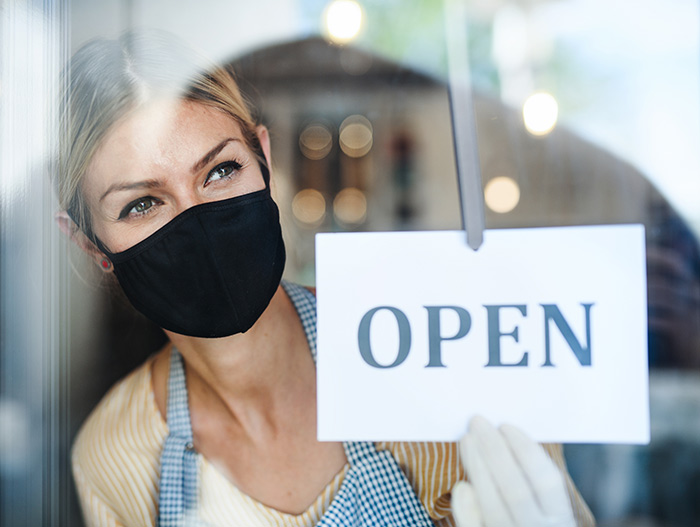
As Massachusetts begins to lift stay-at-home orders, here's what your business needs to know about safely resuming operations.
In the midst of the COVID-19 pandemic, many states have relaxed their stay-at-home orders and begun to reopen non-essential businesses. For business owners, this means navigating a new world of social distancing, face coverings and decreased in-store capacity as consumers slowly start to resume their "normal" lives.
For many businesses, the key to getting back to business will be prioritizing the health and safety of both employees and customers in a clear, demonstrable way. You and your staff will need to strictly adhere to and enforce any new health guidelines put in place by your state and/or municipality, and effectively communicate those protocols to your patrons.
If your business is preparing to reopen its doors, here's what you need to know about safely resuming operations while building trust and confidence among your customer base.
Prepare your workplace for the transition
Social distancing guidelines set forth by the Centers for Disease Control and Prevention (CDC) require at least six feet of space between individuals whenever possible. This may mean installing physical barriers in your store or office, changing your layout to create more space between workstations, closing communal spaces and staggering shifts and breaks to minimize any unnecessary interactions.
Create an employee wellness plan to monitor health
Local, state and federal guidelines for specific industries are changing daily as COVID-19 evolves.
Public health organizations have recommended businesses that are able to operate remotely (fully or partially) continue to do so to mitigate the spread of the virus. In fact, many large corporations have extended their work-from-home orders to October 2020 for all employees whose jobs can be done remotely. However, if your employees will soon be reconvening in the workplace, include the following items in your wellness plan:
- Personal protective equipment (PPE) or face coverings for employees. Proper PPE has been an important part of protecting essential healthcare workers and limiting the spread of the virus throughout the pandemic. The Occupational Safety and Health Administration (OSHA) does require certain industries to use standardized PPE like N95 masks, but if yours is not one of them, you may wish to provide cloth face coverings, masks and/or gloves for your employees to wear in the workplace.
- Temperature checks to enter a workplace. According to Stone, temperature checks are already a requirement for some essential workers and are expected to be a requirement for reopening many types of businesses. If you decide or are required to implement temperature checks, Stone says to designate one person as the recorder, such as a manager.
- Daily wellness checks. Self-reported "symptom surveys" that are completed by employees before entering the workplace are likely here to stay, too, said Stone.
- Employer-led COVID testing for workers. Stone believes the onus may soon be on employers to have a record of employee COVID-19 status or vaccination. As scientific and medical research on COVID immunity evolves, this may become part of the employer testing process as well.
Implement safety measures for handling physical items
Non-essential retail stores are opening up across the country, even if some states only allow for curbside pickup for now. Retailers should take a cue from the restaurant industry, which implemented certain health and safety protocols for customer pickup orders at the start of the pandemic. This is not only a good, practical public health strategy, but it may help customers feel more confident about shopping with you.
Most businesses aren't expecting things to go 'back to normal' right away and realize it will take time for public fear to fade.
Here are a few things you can do to minimize person-to-person contact if your business sells physical items to customers:
- Limit payment options to cashless methods. Cash touches lots of hands and requires close contact, so you may wish to require cashless payment options like online payments or credit/debit card only. Stoga reminded retailers that this option does have equity issues, as some consumers may not have access to credit or debit cards.
- Set up a 'pickup rack' at the store entrance. Clients can stay in their cars and receive a text when their items are ready to go and placed on the rack.
- Place safety seals on bags. Just as restaurants did, consider using bags with safety seals when packaging your customers' orders. Stoga noted that this tends to allay the fears of anxious patrons.
Communicate your plans clearly to employees and customers
Once you have your health and safety plans in place for your reopening, you need a clear communication strategy to ensure your staff and customers understand their role in mitigating COVID-related risks.
Communication is critical. With so much uncertainty in the news and employees asking questions, we have been communicating even more. Holding short huddles everyday with our teams to share anything new has really helped.
When you tell your customers about your reopening plans, be ready with a unified message across all your channels, and reiterate that message in-store and through regular transactional touchpoints. Most importantly, be prepared to provide updates, take feedback to heart and adapt your operations accordingly.

